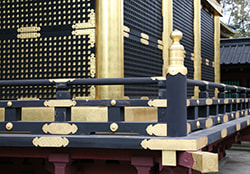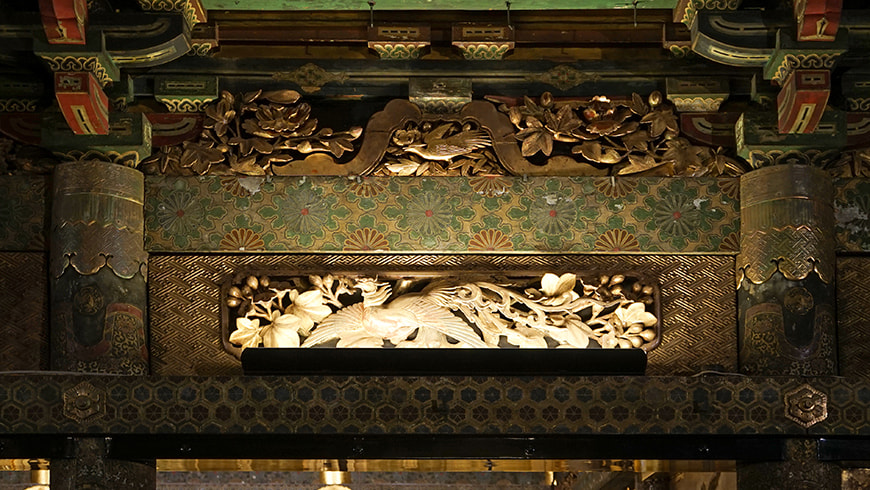About the structure of Ueno Toshogu
Q: I heard that the main building was reconstructed in 1651. Are there other extant buildings?
All the buildings, including the main building, Chinese-style gate and see-through fence, exist as there were at that time.
Q: It is said that there are pieces of work created by Jingoro Hidari, a carver in the early Edo Period. Which pieces are done by him?
It is said that the only pieces of work that Jingoro Hidari created are four dragon relieves on the Chinese-style gate.
Q: Who made the see-through fence?
It is said that painters in the Kano school made rough sketches, and carvers carved images based on the sketches. 257 images are carved on the see-through fence. Plants and animals in fields and mountains are carved on the upper part of it, and water creatures in seas and rivers on the lower part. Although a large number of small birds are carved on the upper part, some insects and animals, such as wild boars and deer are also on it. Seabirds, fish and shellfishes, catfishes, and frogs are on the lower part. Many kinds of animals and plants are carved. Tree sparrows, swallows, butterflies and autumn leaves that are familiar to us are also on it, so we can enjoy seeing it.
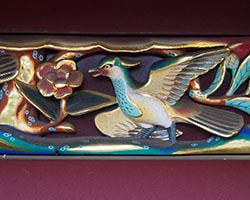
Relief of a Satyr tragopan on the see-through fence
Q: I heard that the see-through fence was restored during the restoration and renovation work some years ago. How was it restored?
Prior to the restoration work, all images on the fence were coated with red lacquer. It is considered that, since Toshogus in Nikko and Kunozan are colored, Ueno Toshogu was also done in color. It was thought that, if red lacquer was removed, underlying colors appeared, and the fence could be restored to its original state. However, it seemed that red lacquer was applied after removing underlying colors during the repair work in 1965. So there were no underlying colors. This time, all animals and plants on 257 relieves were identified when applying colors to them. So they were colored as close to real animals and plants as possible.
Q: Did you refer to Nikko Toshogu when restoring the fence?
Since there are a lot of relieves in Nikko Toshogu, we referred to them.
Q: Could you tell me about the structure of the main building?
The main building has "Gongen-zukuri," a complex Shinto shrine structure. There are a worship hall at the front and a sanctuary at the back. The main building consists of three halls: the worship hall, sanctuary, and offertory hall, called "Ishino-ma," or stone hall, that is one step lower hall, and connects the worship hall and sanctuary.
Although outer walls were restored and repainted, sliding-door pictures by Tanyu Kano still remain on inner walls as they were. If the pictures are touched up, the value as cultural assets is lost. Minimal repair work, such as recoating of flaked gold leaves and lacquer and preventing colors from coming off, was conducted this time, so the original sate of them can be seen.
Q: Which ones are designated as nationally important cultural properties?
The main building, see-through fence, Chinese-style gate, 48 copper lanterns and large stone torii gateway are designated as important cultural properties.
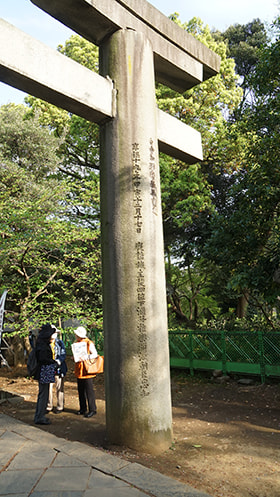
Large stone torii gateway
Q: How many lanterns are placed on the approach?
There are 48 copper and about 200 stone lanterns. Most of them were donated when the main building was reconstructed in 1651. The oldest lantern is a copper lantern donated by Takatora Todo in 1628, the year of the 13th anniversary of Ieyasu's death. Although the copper lanterns have octagonal base, this lantern is little bit smaller, and has a circular base.
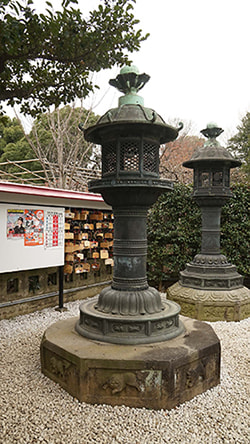
Copper lantern donated by Takatora Todo
Q: Do the approach remain as it was at that time?
The approach leading to the large stone torii gateway is unchanged. According to old materials, the approach extended to Shinobazuno Pond. It has been gradually reduced in size due to park improvement and other projects.
Q: There are steps descending to a torii gateway at the side of Shinobazu-guchi. Do people also visit the shrine from that gateway?
Yes.
Q: Do many people visit the shrine from Hirokoji?
Yes. It is the main approach to the shrine. The approach with a torii gateway facing Shinobazu-guchi is called "Shinobazu Sando." Its stone steps were not made by the Tokugawa shogunate, but created with donations from worshipers. They were rare stone steps even at that time, which are composed of short and long steps that are alternately combined.
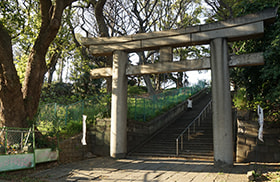
Torii at Shinobazu-guchi
About cooperation
Q: Does Ueno Toshogu currently cooperate with Nikko and Kunozan Toshogus?
There is an association of Toshogus, which is managed by Nikko Toshogu. Since each Toshogu is an independent religious corporation, there is not so strong relations. However, we have sometimes received newsletters, and met chief priests of other Toshogus.
As an important cultural property
Q: Can people look around the main building?
People could previously enter the main building. However, the building without an aseismatic structure is not currently open to the public due to damage from the Great East Japan Earthquake occurred during the renovation work.
Q: What kind of people visit the shrine?
There are many visitors from abroad. Half of visitors are from abroad even on weekdays. Sometimes about 70% of visitors are overseas visitors. Since about 200,000 overseas visitors come to the shrine every year, in addition to a Japanese language version, our brochures, website and information boards in the precincts are written in English. Votive wooden tablets written in a variety of languages by visitors are also seen in the precincts.

Q: What kind of information do overseas visitors see and come to this shrine?
It seems that this shrine has been introduced in guidebooks and websites. Many of those visitors drop in the shrine on their way to Asakusa after seeing Akihabara because the shrine is located in the middle between Akihabara and Asakusa. Some of them come to the shrine after visiting museums.
Q: Do you plan to attract more visitors in the future?
Many foreign coins have been thrown into offertory boxes. We have counted those coins every month. The most commonly found coins are Taiwanese ones, followed by American, Korean and Chinese ones. Those countries are top five countries. Many Thai coins are also found. We also see Vietnamese and European coins. Sometimes Scandinavian and Russian coins are found.
Q: Do you plan to attract more visitors in the future?
We want people not only in Japan but foreign countries to know Toshogu, an important cultural property, so we have created the English version of the website besides the Japanese one.
Many people come to the shrine when the Peony Garden is open. In the last year (2018), we illuminated the main building because we were asked to do so by Taito City. People both at home and abroad could enjoy seeing the golden building that stood out in the dusk. We also plan to light up the main building this year.
About the Peony Garden
Q: When was the Peony Garden founded?
When we see old paintings and other materials, it turns out that the site of the present Peony Garden was a thickly wooded place. They wanted to develop the place where visitors to graves could enjoy, so the garden was created in 1980. They selected peonies because many peonies are engraved on sculptures in the main building, and, since the peony is called "the king of 100 flowers," it is suitable for Ueno Toshogu. (continued in the next page)
